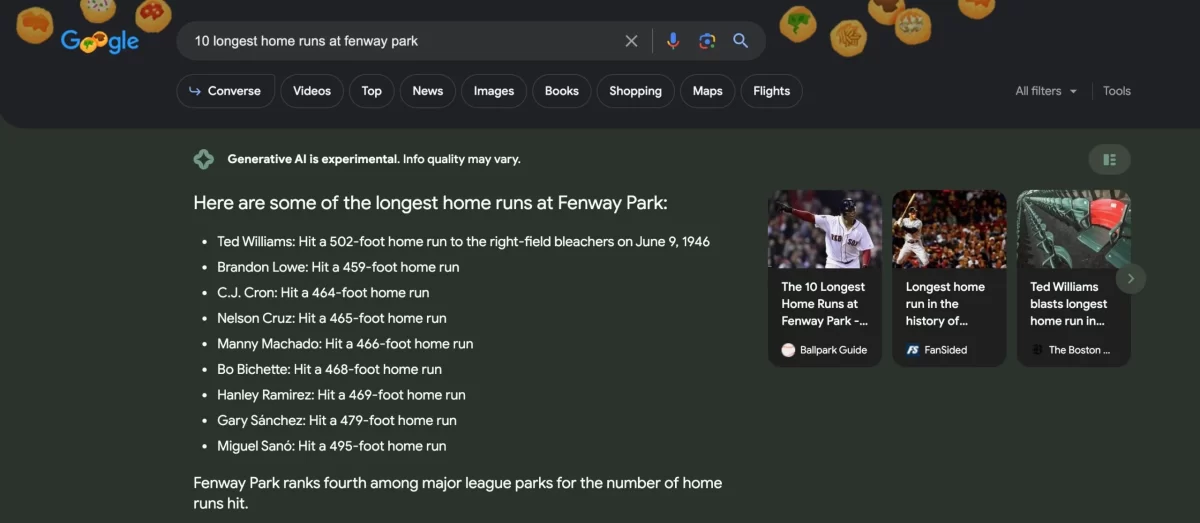In May 2023, Google introduced its new Generative Search Experience (SGE) feature, integrating AI-generated responses into certain search results. Powered by advances in large language models, SGE aims to provide quick overviews and multiple perspectives summarized from across the web. But how exactly does this new addition to Google Search work and what are the implications? This comprehensive FAQ examines SGE in-depth.
What is the Google Generative Search Experience and how was it launched?
The Generative Search Experience (SGE) is a new experimental search feature that Google unveiled publicly on May 26, 2023 during its Search On 22 event. For select searches, SGE displays a snippet of text summarizing key information above the traditional list of search results.
These AI-generated responses aim to provide an overview of important factors to consider, different viewpoints from across the web, and potential next steps or follow-up questions to explore a topic more deeply. SGE uses the latest advances in generative AI, including large language models, to synthesize these responses on the fly.
Initially, SGE is launching in a limited beta through Google’s Search Labs program. It is currently enabled for a small portion of English searches in the United States on desktop and mobile. Access requires signing up through Search Labs and will be expanding gradually over time based on testing and feedback.
How are the SGE snippets and summaries generated?
The AI-written text displayed in SGE snippets is created by leveraging Google’s existing Knowledge Graph, Featured Snippets, and structured data from websites relevant to the search query. This allows Google’s algorithms to identify key concepts, entities, and perspectives to cover in the summary.
The information from across the web is then combined and run through a proprietary large language model developed by Google researchers specifically for summarization of search results. Fine-tuning the model on Google’s search data enables it to generate natural sounding overviews reflecting diverse sources while upholding high quality standards.
What triggers the SGE features to appear for a search?
So far, Google has enabled SGE for broad, complex informational queries where summarizing key details and trade-offs can aid decision-making. For example, queries like “best stroller for city living” or “difference between type 1 and type 2 diabetes”.
SGE is also appearing for some comparative shopping queries to summarize product options, reviews, and factors to consider. Google seems to be selectively surfacing SGE where it has enough structured data to generate a useful overview from multiple perspectives.
How are sources and websites credited within SGE?
As part of its summarization, the SGE snippet cites and links out to the third-party webpages used as sources for the generated text. On desktop, clicking the citation shows a preview of the content highlighted.
The order of citations corresponds to the length of unique text referenced from each site. This provides attribution proportional to the amount of content contributed. Even if one site has the most relevant data, SGE diversifies citations – likely as part of Google’s effort to continue driving traffic to sources.
How is the citation rank decided?
The ranking of the citations is determined by the total number of characters from each website that get cited within the SGE snippet. Sites that contribute more unique text tend to be ranked higher in the list of citations.
How is the image for each cited web page chosen?
For the thumbnail images representing each cited website, Google will primarily select the top inline image from the referenced page. If no inline image is available, it may use a lower image or fall back to the Open Graph meta image for the page. The selected image is then cropped to maintain a consistent 1.45:1 aspect ratio.
What are some of the potential impacts – both positive and negative – of SGE?
For sites producing unique high-quality content, being referenced in SGE could drive more traffic and links. However, if AI summaries fully satisfy informational queries, it could reduce visits to other explanatory content. The impact on branded search terms remains uncertain.
While aiming to summarize neutrally, limitations in current AI could lead to incorrect, biased, or offensive generated text. Google says it has guardrails in place during training, but issues will still occur. Allowing users to view sources provides transparency around where the information is coming from.
As this major new search feature expands, Google will need to take a thoughtful approach accounting for all stakeholders – searchers, publishers, and businesses alike. The technology shows promise, but also disruptive potential as AI takes on a greater curation role.
